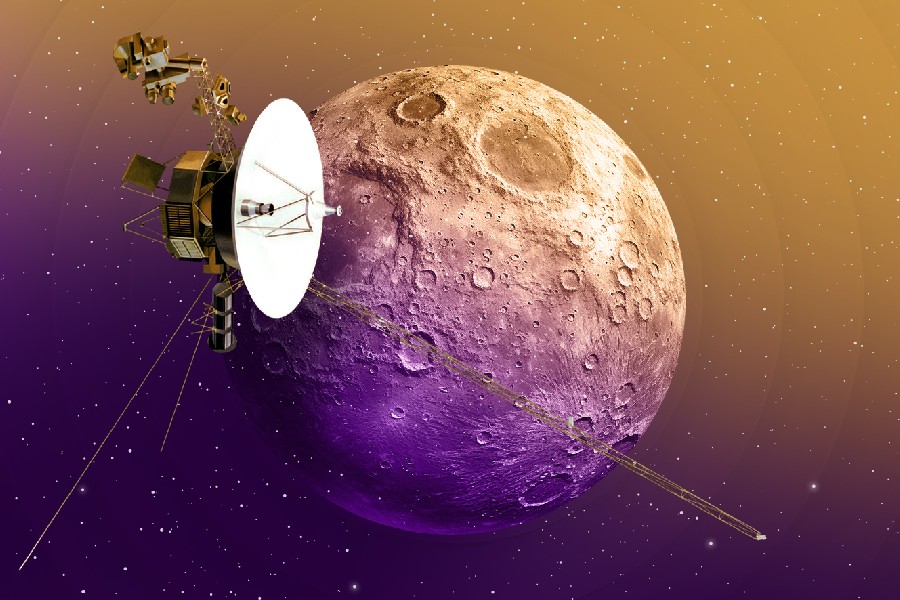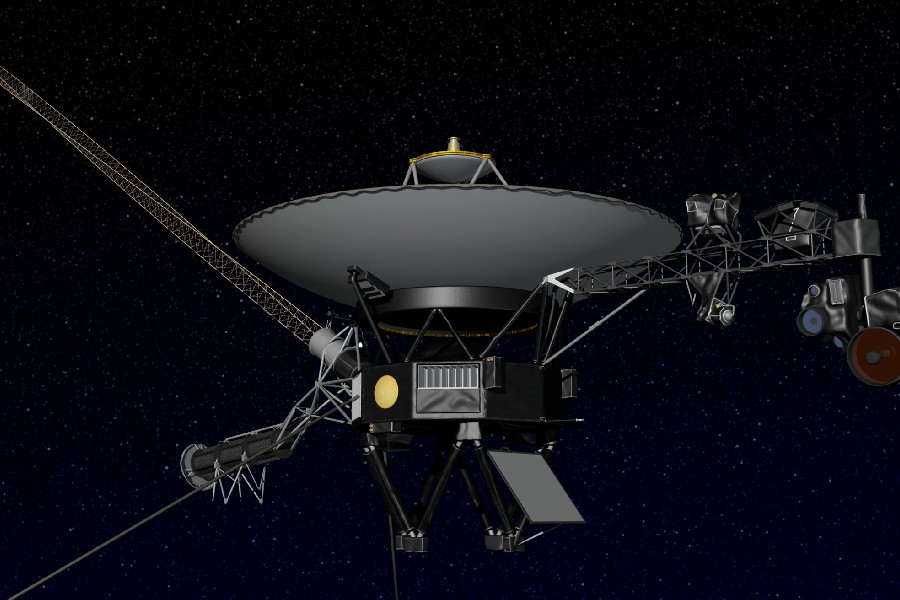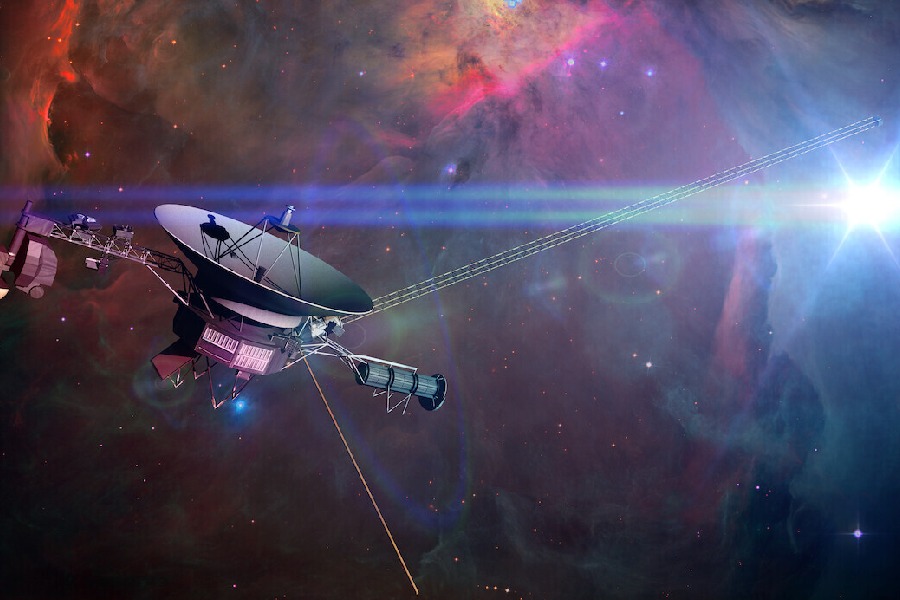Have you read about the legendary Voyager spacecraft, still faithfully beaming findings across billions of miles after over 40 years in space? These historic NASA probes ventured farther than any human creation in history. In exploring the epic Voyager missions, we’ll unravel an inspirational saga of our first emissaries into the great unknown realm of interstellar space and beyond the influences of our Sun.
Launched just weeks apart in 1977, the identical Voyager 1 and 2 probes conducted a brilliant Grand Tour. It revealed Jupiter, Saturn, Uranus, and Neptune in unprecedented detail for the first time before their fates diverged.
As the pioneer first to escape the Sun’s sphere of magnetic particles spread across space, Voyager 1 continues blazing a trail. It has traveled over 14 billion miles away into the uncharted vastness between alien star systems.
We’ll uncover how the intrepid Voyager twins transmitted iconic images across unfathomable distances back to eager Earthly crowds awaiting each close encounter.

What are the Voyager Missions?
The Voyager missions refer to two robotic spacecraft, Voyager 1 and Voyager 2, launched by NASA in 1977.
These spacecraft were designed to study the outer planets of our solar system and their moons. The primary objectives were to gather information about Jupiter and Saturn, with Voyager 2 also visiting Uranus and Neptune.
The Voyager missions achieved key accomplishments. They provided detailed images and data about the atmospheres, rings, and moons of the target planets. They also found active volcanoes on Jupiter’s moon Io and observed complex ring structures around Saturn.
Voyagers 1 and 2 Overview
The Voyager 1 and Voyager 2 missions comprise ambitious interplanetary NASA probes launched in 1977. Despite being copies with identical hardware, scientific instruments, and objectives, their fates later diverged towards distinct pioneering missions—both shattering records for human spaceflight.
While Voyager 1 flew beyond the planets towards interstellar space, it scored several firsts exploring the giant Jupiter and Saturn systems. Voyager 2, on the other hand, culminated in an unprecedented “Grand Tour” before ultimately joining its twin. Voyager 2 achieved close encounters surveying all four gas giants on the interstellar voyage.
Mission objectives
The core Voyager mission directive aimed to conduct comprehensive up-close investigations of Jupiter, Saturn plus their intriguing moons, optimally Uranus and Neptune too.
Voyager would reveal unprecedented details on planetary atmospheres, magnetic fields, surfaces, and moon compositions for a better understanding of origins plus evolution.
A secondary objective included gathering the first extensive close-up spacecraft exploration of the outer solar system. Voyager 2 launched first on August 20, 1977, followed by Voyager 1 on September 5, 1977, just 16 days later.
Instruments on Board
Instrumentation overview
The Voyager spacecraft carries cutting-edge science instruments to conduct various important measurements. These include plasma waves and magnetometers for analyzing charged particles and magnetic fields.
Optical cameras snap images while spectrometers gather key atmosphere data like composition. The imaging radar precisely maps planetary body surfaces.
Technological innovations
Notably, the Voyagers house the first-ever computer command system designed specifically for deep space probe data retrieval and navigation at extreme distances.
Advanced data encoders maximized compression for the low bandwidth transmitters. This enabled them to return imagery from over seven billion miles away. The craft even touted an innovative TTL integrated circuit manufacturing technique enhancing reliability.
Spacecrafts Design and Construction
Engineers designed the Voyager spacecraft specifically for comprehensive outer solar system exploration across an extended timeframe lasting decades. The 650 kg vehicles feature a three-axis stabilized structure ideal for conducting planetary encounters, housing instruments, and maneuvering antennas.
Components boast durability, sustaining years of intense radiation plus subzero temperatures ranging from -175 to over 100°C in space.
Engineering challenges
Constructing a functioning spacecraft plus precisely integrating sensitive tools for visiting multiple planets confronted immense obstacles. Myriad technical capabilities like imaging, data encoding, computer command sequences, and long-range communications had to synchronize flawlessly.
Interplanetary Design Features
The compact spacecraft design integrated instruments best suited for up-close observations plus readings within extreme alien environments. It allowed access to maximum data quality after crossing hundreds of millions of miles stretched over years.
Modular compartmentalization plus redundancy across systems prepared the spacecraft for the unpredictable demands of exploring mysterious planetary kingdoms.
Launch and Early Journey
The Voyager mission commenced when powerful Titan IIIE-Centaur rockets propelled the precisely engineered vehicles free of Earth’s gravity into space from Cape Canaveral on August 20th and September 5th, 1977, respectively. After escaping Earth’s orbit towards a Mars gravity assist trajectory, the earliest phases brought swift challenges even before reaching the Red Planet.
Launch events
During the first critical minutes, the rocket boosters and various stages jettisoned off seamlessly while protective shrouds deployed to shield Voyager 2’s instruments and delicate hardware from intense vibrations. Radio confirmation of the solar panel unfurling marked successful activations.
Early mission challenges
Voyager 1 experienced a roller coaster thruster problem, causing orientation issues in the initial weeks. Later, as Voyager 1 utilized Mars’ gravitational influence to slingshot towards Jupiter, targeting calibration became complicated.
This happened when the onboard computer temporarily failed, but the craft recovered using backups.

Accomplishments of the Voyager Missions
Ultimately sailing over billions of miles whilst unveiling mysteries of the giant outer planets and their cosmic neighborhoods, the Voyager twin probes overwhelmingly exceeded expectations across scientific discovery and spaceflight achievements over their four-decade journey.
Planetary discoveries
Voyager imagery and readings revealed key details on the four gas giants – Jupiter, Saturn, Uranus, and Neptune. This includes characteristics of turbulent storms, intricately structured rings, hazy vertical atmospheres, and almost 80 astonishing moons across these massive planetary systems.
This included uncovering erupting volcanoes on Io, icy geysers on Triton, and an ocean beneath Europa’s cracked surface.
Technological milestones
As the most distant human-made objects at over 14 billion miles from Earth and still communicating, the Voyagers have set records. They demonstrated unprecedented deep-space navigation precision. They stretched 1970s automation and data transmission farther than conceived.
Voyager also achieved many spaceflight firsts. These include initial close flybys of Uranus and Neptune. They also include crossing the termination shock boundary beyond the solar system. Additionally, Voyager cameras managed to photograph Earth as a pale blue dot. This happened beyond Neptune’s orbit, with cameras looking back from such extreme distances.
Reaching Interstellar Space with Voyager 1 and 2
Boldly going where no spacecraft had ventured before, both Voyager 1 and 2 eventually crossed the boundary, marking the edge of our Sun’s cosmic neighborhood to embark on the first human artifacts to infiltrate interstellar space.
This historic achievement capped the originally intended planetary tour with another major milestone decades later.
Voyager 1’s interstellar crossing
In perhaps its most groundbreaking act, Voyager 1 detected drastic dips in solar particles in mid-2012. This signaled it passed into the uncharted frontier beyond our solar system’s influence, approximately 11 billion miles from the Sun.
This milestone occurred over 35 years after the launch. Voyager 1 continues charting the enigmas of the cosmos in the absence of solar effects for future deep spacecraft to one day come.
Voyager 2’s interstellar transition
Voyager 2 culminated its unique “Grand Tour” visiting all outer planets by plunging into the interstellar medium a few years behind its twin in 2018.
Voyager 2 revealed key data on differences between the solar emission boundaries. This was thanks to its divergent trajectory, previously examining Neptune’s magnetosphere over 30 astronomical units away.
Data Collected from Interstellar Space by Voyagers 1 and 2
As the only human-made craft infiltrating local interstellar space, both Voyager probes actively gather measurements from this enigmatic region devoid of solar effects as they press onwards through the stars.
Interstellar measurements
The stalwart Voyagers detect counting rates, tracing various interactions. These include galactic cosmic rays, solar particles, and magnetic fluxes. The Voyagers also sample the odd plasmas filling interstellar space.
Voyager findings characterized the “magnetic highway’s” odd 25-degree offset. This was an offset from the expected heliospheric alignment. The Voyagers also measured ionized densities matching models that predict one loose hydrogen atom per cubic centimeter in the Milky Way.
Scientific implications
The study of energetic particles enables an estimate of the rate at which future deep space astronauts would accrue radiation dosage.
Most excitingly, observations train more acute “senses” for detecting and describing interstellar phenomena robotically until more advanced probes like NASA’s upcoming Interstellar Probe can chase 2030s Voyager trajectories across greater gulfs beyond.
Scientific Findings from the Voyager’s Mission
Jupiter’s magnetic field
The twin Voyagers revealed Jupiter’s magnetosphere stretches wider than originally conceived after localizing the source of billions of watts of radio bursts to interactions along Io’s ionosphere. Before Voyager, the immense scale was underestimated.
Aurorae activity
Voyager observed auroras using ultraviolet measurements at Jupiter, Saturn, and Uranus. It analyzed light composition and variability, indicating particle densities around the planets’ magnetic fields. Voyager also picked up radio signals from lightning strikes triggered by meteoroid impacts in their atmospheres.
Additionally, over 68,000 images revealed diverse discoveries including:
- Ice plumes crystallizing on Saturn’s moon Enceladus
- Io’s shifting terrain hints that subsurface magma flows
- Hazy neon glows above Titan, likely from complex chemistry
The rich insights from Voyager will fuel outer planets’ exploration for generations.

Conclusion
We hope understanding the epic Voyager missions has illuminated these iconic probes’ profound impacts, revealing our solar system’s outer worlds and pioneering humanity’s first forays beyond towards the stars.
As the article traced, the Voyagers’ Grand Tour and ensuing three decade-plus journeys stand as towering achievements in space exploration – unveiling Jupiter’s turbulent weather, Saturn’s splendid rings, and the solar winds’ distant bounds.
